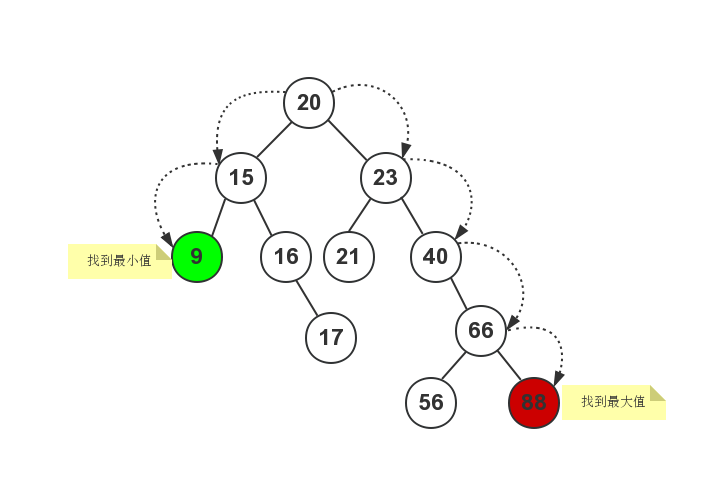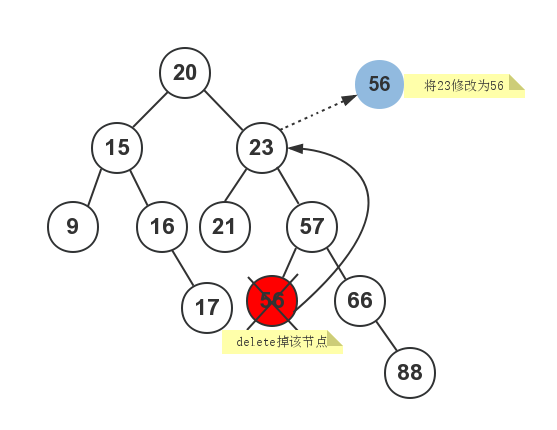啥是二叉查找树
在数据结构中,有一个奇葩的东西,说它奇葩,那是因为它重要,这就是树。而在树中,二叉树又是当中的贵族。二叉树的一个重要应用是它们在查找中的应用,于是就有了二叉查找树。 使二叉树成为一颗二叉查找树,需要满足以下两点:
- 对于树中的每个节点X,它的左子树中所有项的值都要小于X中的项;
- 对于树中的每个节点Y,它的右子树中所有项的值都要大于Y中的项。
二叉查找树的基本操作
以下是对于二叉查找树的基本操作定义类,然后慢慢分析是如何实现它们的。
template<class T> class BinarySearchTree { public: // 构造函数,初始化root值 BinarySearchTree() : root(NULL){} // 析构函数,默认实现 ~BinarySearchTree() {} // 查找最小值,并返回最小值 const T &findMin() const; // 查找最大值,并返回最大值 const T &findMax() const; // 判断二叉树中是否包含指定值的元素 bool contains(const T &x) const; // 判断二叉查找树是否为空 bool isEmpty() const { return root ? false : true; } // 打印二叉查找树的值 void printTree() const; // 向二叉查找树中插入指定值 void insert(const T &x); // 删除二叉查找树中指定的值 void remove(const T &x); // 清空整个二叉查找树 void makeEmpty() const; private: // 指向根节点 BinaryNode<T> *root; void insert(const T &x, BinaryNode<T> *&t) const; void remove(const T &x, BinaryNode<T> *&t) const; BinaryNode<T> *findMin(BinaryNode<T> *t) const; BinaryNode<T> *findMax(BinaryNode<T> *t) const; bool contains(const T &x, BinaryNode<T> *t) const; void printTree(BinaryNode<T> *t) const; void makeEmpty(BinaryNode<T> *&t) const; };
findMin和findMax实现
根据二叉查找树的性质:
- 对于树中的每个节点X,它的左子树中所有项的值都要小于X中的项;
- 对于树中的每个节点Y,它的右子树中所有项的值都要大于Y中的项。
我们可以从root节点开始:
- 一直沿着左节点往下找,直到子节点等于
NULL为止,这样就可以找到最小值了; - 一直沿着右节点往下找,直到子节点等于
NULL为止,这样就可以找到最大值了。
如下图所示: 
在程序中实现时,有两种方法:
- 使用递归实现;
- 使用非递归的方式实现。
对于finMin的实现,我这里使用递归的方式,代码参考如下:
BinaryNode<T> *BinarySearchTree<T>::findMin(BinaryNode<T> *t) const { if (t == NULL) { return NULL; } else if (t->left == NULL) { return t; } else { return findMin(t->left); } }
在findMin()的内部调用findMin(BinaryNode<T> *t),这样就防止了客户端知道了root根节点的信息。上面使用递归的方式实现了查找最小值,下面使用循环的方式来实现findMax。
template<class T> BinaryNode<T> *BinarySearchTree<T>::findMax(BinaryNode<T> *t) const { if (t == NULL) { return NULL; } while (t->right) { t = t->right; } return t; }
在很多面试的场合下,面试官一般都是让写出非递归的版本;而在对树进行的各种操作,很多时候都是使用的递归实现的,所以,在平时学习时,在理解递归版本的前提下,需要关心一下对应的非递归版本。
contains实现
contains用来判断二叉查找树是否包含指定的元素。代码实现如下:
template<class T> bool BinarySearchTree<T>::contains(const T &x, BinaryNode<T> *t) const { if (t == NULL) { return false; } else if (x > t->element) { return contains(x, t->right); } else if (x < t->element) { return contains(x, t->left); } else { return true; } }
算法规则如下:
- 首先判断需要查找的值与当前节点值的大小关系;
- 当小于当前节点值时,就在左节点中继续查找;
- 当大于当前节点值时,就在右节点中继续查找;
- 当找到该值时,直接返回true。
insert实现
insert函数用来向二叉查找树中插入新的元素,算法处理如下:
- 首先判断需要插入的值与当前节点值得大小关系;
- 当小于当前节点值时,就在左节点中继续查找插入点;
- 当大于当前节点值时,就在右节点中继续查找插入点;
- 当等于当前节点值时,什么也不干。
代码实现如下:
template<class T> void BinarySearchTree<T>::insert(const T &x, BinaryNode<T> *&t) const { if (t == NULL) { t = new BinaryNode<T>(x, NULL, NULL); } else if (x < t->element) { insert(x, t->left); } else if (x > t->element) { insert(x, t->right); } }
remove实现
remove函数用来删除二叉查找树中指定的元素值,这个处理起来比较麻烦。在删除子节点时,需要分以下几种情况进行考虑(结合下图进行说明): 如下图所示: 
- 需要删除的子节点,它没有任何子节点;例如图中的节点9、节点17、节点21、节点56和节点88;这些节点它们都没有子节点;
- 需要删除的子节点,只有一个子节点(只有左子节点或右子节点);例如图中的节点16和节点40;这些节点它们都只有一个子节点;
- 需要删除的子节点,同时拥有两个子节点;例如图中的节点66等。
对于情况1,直接删除对应的节点即可;实现起来时比较简单的;
对于情况2,直接删除对应的节点,然后用其子节点占据删除掉的位置;
对于情况3,是比较复杂的。首先在需要被删除节点的右子树中找到最小值节点,然后使用该最小值替换需要删除节点的值,然后在右子树中删除该最小值节点。
假如现在需要删除包含值23的节点,步骤如下图所示: 
代码实现如下:
template<class T> void BinarySearchTree<T>::remove(const T &x, BinaryNode<T> *&t) const { if (t == NULL) { return; } if (x < t->element) { remove(x, t->left); } else if (x > t->element) { remove(x, t->right); } else if (t->left != NULL && t->right != NULL) { // 拥有两个子节点 t->element = findMin(t->right)->element; remove(t->element, t->right); } else if (t->left == NULL && t->right == NULL) { // 没有子节点,直接干掉 delete t; t = NULL; } else if (t->left == NULL || t->right == NULL) { // 拥有一个子节点 BinaryNode *pTemp = t; t = (t->left != NULL) ? t->left : t->right; delete pTemp; } }
makeEmpty实现
makeEmpty函数用来释放整个二叉查找树占用的内存空间,同理,也是使用的递归的方式来实现的。具体代码请下载文中最后提供的源码。
转载:http://www.jellythink.com/archives/692
@2017-03-29 20:25:17 测试通过:
/*! * file 二叉搜索树的实现.cpp * * author ranjiewen * date 2017/03/29 17:13 * * */ #include <stdio.h> #include <stdlib.h> typedef int ELementType; typedef struct BSTreeNode* BSTree; struct BSTreeNode //不可以typedef;然后再次typedef; { ELementType Data; BSTree Left; BSTree Right; }; //typedef BSTreeNode* Position; typedef BSTree Position; Position Find(ELementType x, BSTree BST); //返回所在节点的地址 Position FindMin(BSTree BST); Position FinMax(BSTree BST); BSTree Insert(ELementType x, BSTree BST); BSTree Delete(ELementType x, BSTree BST); //查找的效率取决于树的高度,和树的组织方法有关 Position Find(ELementType x, BSTree BST) { if (!BST) { return NULL; } if (x > BST->Data) { return Find(x, BST->Right); //尾递归都可以用循环的实现 } else if (x < BST->Data) { return Find(x, BST->Left); } else //x==BST->Data { return BST; } } //非递归的执行效率高,可将“尾递归”函数改为迭代函数实现 Position IterFinde(ELementType x, BSTree BST) { while (BST) { if (x > BST->Data) { BST = BST->Right; } else if (x < BST->Data) { BST = BST->Left; } else { return BST; } } return NULL; } //递归实现 Position FindMin(BSTree BST) { if (!BST) { return NULL; } else if (!BST->Left) { return BST; //找到最左叶节点并返回 } else { return FindMin(BST->Left); } } Position FinMax(BSTree BST) { if (!BST) { return NULL; } while (BST->Right) { BST = BST->Right; //沿右分支继续查找,直到最右节点 } return BST; } //关键是要找到元素应该插入的位置,可以采用与Find类似的方法 BSTree Insert(ELementType x, BSTree BST) { if (!BST) { BST = (BSTree)malloc(sizeof(BSTreeNode)); BST->Data = x; BST->Left = NULL; BST->Right = NULL; } else //开始找到要插入元素的位置 { if (x < BST->Data) { BST->Left = Insert(x, BST->Left); //将子树的根节点挂在父节点下 } else if (x > BST->Data) { BST->Right = Insert(x, BST->Right); } //else x已经存在 } return BST; } //删除节点的三种情况: // 1.要删除的是叶节点:直接删除,并修改其父节点为NULL // 2.要删除的结点只有一个孩子结点: 将其父结点的指针指向要删除结点的孩子结点 // 3.要删除的结点有左、右两棵子树: 用另一结点替代被删除结点:右子树的最小元素 或者 左子树的最大元素 BSTree Delete(ELementType x, BSTree BST) { Position temp; if (!BST) { printf("要删除的元素未找到... "); } else if (x < BST->Data) { BST->Left = Delete(x, BST->Left); } else if (x > BST->Data) { BST->Right = Delete(x, BST->Right); } else //找到要删除的节点 { if (BST->Left&&BST->Right) /*被删除的节点有左右两个子节点*/ { temp = FindMin(BST->Right); BST->Data = temp->Data; BST->Right = Delete(BST->Data, BST->Right); } else //被删除节点有一个或者无子节点 //这里的理解:已经到尾节点了,只有一个元素了 { temp = BST; if (!BST->Left) //有右孩子 { BST = BST->Right; } else if (!BST->Right) { BST = BST->Left; } free(temp); } } return BST; } BSTree CreateBST(BSTree BST) { int N = 0; printf("请输入创建二叉搜索树的元素个数: "); scanf("%d", &N); int data = 0; for (int i = 0; i < N; i++) { //scanf("%d", data); BST=Insert(i + 10, BST);// } return BST; } void PrintBST(BSTree BST) //考虑怎么可视化的输出 { if (BST) //中序打印 { PrintBST(BST->Left); printf("%3d", BST->Data); PrintBST(BST->Right); } } int main() { BSTree root = NULL; //CreateBST(root);void 不行,要考虑怎么将节点传出来; 1.根据返回值 2.用传指针的方式,所有函数形参改为指针的指针&root root = CreateBST(root); PrintBST(root); printf(" "); BSTree temp; temp = Find(12, root); if (temp) { printf("search success!,search data is %d. ", temp->Data); } else { printf("search failed! "); } temp = IterFinde(12, root); if (temp) { printf("search success!,search data is %d. ", temp->Data); } else { printf("search failed! "); } root=Insert(8, root); PrintBST(root); printf(" "); root=Delete(12, root); PrintBST(root); printf(" "); return 0; }
补充:今天做了一个实验,感觉删除操作没有理解
#include <stdio.h> #include <stdlib.h> typedef struct node { int key; struct node *LChild, *RChild; //孩子指针 }BSTNode, *BSTree; //定义二叉树----查找树 void CreatBST(BSTree *bst); BSTree SearchBST(BSTree bst, int key); void InsertBST(BSTree *bst, int key); BSTNode * DelBST(BSTree t, int k);//以上是函数的声明 void print_bst(BSTree t) //打印 { if (t)//中序顺序打印 { print_bst(t->LChild); printf("%d ", t->key); print_bst(t->RChild); } } const int n = 10; /*创建树*/ void CreatBST(BSTree *bst) { printf("请输入%d个数创建二叉搜索树:",n); int i; int key; *bst = NULL; for (i = 1; i <= n; i++) { scanf("%d", &key); InsertBST(bst, key); //创建 }; } /*寻找*/ BSTree SearchBST(BSTree bst, int key) { if (!bst) return nullptr; //bst为空 else if (bst->key == key) { printf("查找成功!"); return bst; //找到,返回节点 } else if (key < bst->key) return SearchBST(bst->LChild, key); //左孩子递归调用查找 else return SearchBST(bst->RChild, key); //右孩子递归 } /*插入*/ void InsertBST(BSTree *bst, int key) { BSTree t; if (*bst == NULL) { t = (BSTree)malloc(sizeof(BSTNode)); //树为空,申请空间 t->key = key; t->LChild = NULL; t->RChild = NULL; *bst = t; //插入 //printf("插入成功!"); } else if (key <(*bst)->key) InsertBST(&((*bst)->LChild), key); //插到左子树 else if (key>(*bst)->key) InsertBST(&((*bst)->RChild), key); //插到右子树 } /*删除*/ //有问题?没有理解! BSTNode * DelBST(BSTree t, int k) //根据LR为0或1,删除T中p所指结点的左或右子树 { BSTNode *p, *f, *s, *q; p = t; s = t;// f = NULL; while (p) //树非空,先找到key的位置 { if (p->key == k) //根节点等于K break; f = p; //f记录k所在的节点的 双亲节点 if (p->key > k) //向左子树方向 p = p->LChild; else p = p->RChild; //右 } if (p == NULL) //为空 return t; if (p->LChild == nullptr) //左空 ,下边就是删除过程 { if (f == NULL) t = p->RChild; else if (f->LChild == p) f->LChild = p->RChild; else f->RChild = p->LChild; free(p); //释放空间 } else //右,下边就是删除过程 { q = p; s = s->LChild; while (s->RChild) { q = s; s = s->RChild; } if (q == p) q->LChild = s->LChild; else q->RChild = s->LChild; p->key = s->key; free(s); //释放空间 } return t; } int main() { BSTNode * root=nullptr; int loop, i, data; loop = true; while (loop) { printf(" ***************二叉树操作菜单************** "); printf(" 1.创建 "); printf(" 2.查找 "); printf(" 3.插入 "); printf(" 4.删除 "); printf(" 5.打印 "); printf(" 0.退出 "); scanf("%d", &i); switch (i) { case 0: { loop = false; break; } case 1: { CreatBST(&root); }break; case 2: { printf("Please input the data you want search. "); scanf("%d", &data); SearchBST(root, data); }break; case 3: { printf("Please input the data you want insert. "); scanf("%d", &data); InsertBST(&root, data); printf("插入成功!"); }break; case 4: { printf("Please input the data you want delete. "); scanf("%d", &data); root = DelBST(root, data); }break; case 5:{ printf(" "); if (root != NULL) printf("The BSTree's root is:%d ", root->key); print_bst(root); break; } } } }
//C++实现 #include <iostream> #include <cstring> using namespace std; typedef int KeyType; #define NUM 11 class BinStree; class BinSTreeNode { public: KeyType key; BinSTreeNode *lchild; BinSTreeNode *rchild; BinSTreeNode() { lchild = NULL; rchild = NULL; } }; class BinSTree { public: BinSTreeNode *root; BinSTree() { root = NULL; } ~BinSTree() { //delete root; } BinSTreeNode *BSTreeSearch(BinSTreeNode *bt, KeyType k, BinSTreeNode *&p); void BSTreeInsert(BinSTreeNode *&bt, KeyType k); int BSTreeDelete(BinSTreeNode *&bt, KeyType k); void BSTreePreOrder(BinSTreeNode *bt); bool IsEmpty() { return root == NULL; } }; /** * 二叉树排序查找算法 * 在根指针为bt的二叉排序树中查找元素k的节点,若查找成功,则返回指向该节点的指针 * 参数p指向查找到的结点,否则返回空指针,参数p指向k应插入的父结点 */ BinSTreeNode* BinSTree::BSTreeSearch(BinSTreeNode *bt, KeyType k, BinSTreeNode *&p) { BinSTreeNode *q = NULL; q = bt; while (q) { p = q; if (q->key == k) { return(p); } if (q->key > k) q = q->lchild; else q = q->rchild; } return NULL; } /** * 二叉排序树的插入节点算法 * bt指向二叉排序树的根结点,插入元素k的结点 */ void BinSTree::BSTreeInsert(BinSTreeNode *&bt, KeyType k) { BinSTreeNode *p = NULL, *q; q = bt; if (BSTreeSearch(q, k, p) == NULL) { BinSTreeNode *r = new BinSTreeNode; r->key = k; r->lchild = r->rchild = NULL; if (q == NULL) { bt = r; //被插入节点做为树的根节点 } if (p && k < p->key) p->lchild = r; else if (p) p->rchild = r; } } /** * 先序遍历 */ void BinSTree::BSTreePreOrder(BinSTreeNode *bt) { if (bt != NULL) { cout << bt->key << " "; BSTreePreOrder(bt->lchild); BSTreePreOrder(bt->rchild); } } /** * 二叉排序树的删除结点算法 * 在二叉排序树中删除元素为k的结点,*bt指向二叉排序树的根节点 * 删除成功返回1,不成功返回0. */ int BinSTree::BSTreeDelete(BinSTreeNode *&bt, KeyType k) { BinSTreeNode *f, *p, *q, *s; p = bt; f = NULL; //查找关键字为k的结点,同时将此结点的双亲找出来 while (p && p->key != k) { f = p; //f为双亲 if (p->key > k) p = p->lchild; else p = p->rchild; } if (p == NULL) //找不到待删除的结点时返回 return 0; if (p->lchild == NULL) //待删除结点的左子树为空 { if (f == NULL) //待删除结点为根节点 bt = p->rchild; else if (f->lchild == p) //待删结点是其双亲结点的左节点 f->lchild = p->rchild; else f->rchild = p->rchild; //待删结点是其双亲结点的右节点 delete p; } else //待删除结点有左子树,相当于有二个节点 { q = p; s = p->lchild; while (s->rchild) //在待删除结点的左子树中查找最右下结点 { q = s; s = s->rchild; //找左子树的最大值 } if (q == p) q->lchild = s->lchild; else q->rchild = s->lchild; p->key = s->key; delete s; } return 1; } int main(void) { int a[NUM] = { 34, 18, 76, 13, 52, 82, 16, 67, 58, 73, 72 }; int i; BinSTree bst; BinSTreeNode *pBt = NULL, *p = NULL, *pT = NULL; for (i = 0; i < NUM; i++) { bst.BSTreeInsert(pBt, a[i]); //创建二叉排序树 } pT = bst.BSTreeSearch(pBt, 52, p); //搜索排序二叉树 bst.BSTreePreOrder(pBt); cout << endl; bst.BSTreeDelete(pBt, 13); //删除无左孩子的情况 bst.BSTreePreOrder(pBt); cout << endl; bst.BSTreeDelete(pBt, 76); //删除有左孩子的情况 bst.BSTreePreOrder(pBt); cout << endl; return 0; }